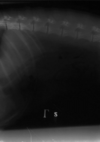Lecture 12 Flashcards
(30 cards)
What are important labels that must go on an X-ray?
- Clinic name - Date - Animals name or number - Owners name
What are two things that a cassette will support?
- Intensifying screens 2. X-ray film
What is essential for a good cassette?
- Must be light proof when closed 2. Radiolucent front 3. Lead back to decrease backscatter 4. Pressure foam pad to ensure good contact between a film and the screen
Briefly explain how the intensifying screen functions:
- Intensifying screen will absorb the transmitted X-rays 2. The luminescent crystals (phosphors) fluoresce visible light when irradiated 3. This fluorescence exposes the X-ray film (95% exposure = visible light and only 5% is actual X-rays)
What is meant by screen speed and what are the three different types of it that will occur?
- Speed = the relative exposure required to give an optical density on the film - FAST = a lower exposure will be required - MODERATE = moderate exposure is required - SLOW = higher exposures required
What factors affect the amount of X-ray energy that is able to be absorbed by the screen and converted to visible light?
- screen phosphor type and screen properties (construction)
What is the effect of a larger crystal size in the intensifying screen?
- greater absorption efficiency (fewer X-rays needed) - greater screen speed = overall effect of a fast but poor grainy quality image
What is the effect of an increase layer thickness?
- larger volume of light = greater absorption efficiency and a greater screen speed
What problem with the intensifying screen would cause small white dots and what would be the solution to this?
Caused by dust and hair between the film and the screen. The resolution would be to clean the screens
What problem with the intensifying screen would cause. multiple small white dots spread diffusely throughout a screen background? What is the solution?
An issue that is caused by old phosphors that are no longer able to fluoresce light? The resolution to this would be to replace the old screen and to purchase a new one.
What are some important considerations when cleaning film screens?
- The screen cleaning product used 2. Lint free cloth (prevent lint artefact) 3. Upright to dry (preventing dust)
What are the two different types of film structure that can be used?
Single of double sides AgBr
On a density/exposure curve what is the effect of a steeper curve?
Steeper curve = greater contrast
What is meant by film latitude? What is a consequence of having higher latitude, what is a benefit?
Film latitude = the range of exposures with acceptable densities. A wider latitude means lower contrast
What are some important considerations when designing film screen combinations?
- Film = sensitive to different colour ranges 2. Correct mix of screen colour and also film sensitivity will mean a greater level of efficiency
What are the two basic systems that are required at any practice?
- Detailed system - small parts, extremities (less than 10 cm thickness) with no grid used 2. Fast system - for use with grids (much thicker - greater than 10 cm thicknesses)
Fill in the diagram below:


What is a latent image?
The film after exposure has a latent image. Latent centres will act as a catalyst for silver formation. The silver deposits will form the black areas of the film
What is involved in the film processing phase?
The developer solution contains a reducing agent and is alkaline. Converts the AgBr areas on the film to silver
What factors influence the developer time of an image?
- Time in developer
- Temperature of the developer solution
- Age of developer solution
- Inactivation of the developer solution
How often should developer solution be changed?
Every 4 to 6 weeks
True or false:
“It is ok to replenish developer solution with water”
Wrong must use a specialised replenisher solution
What is the issue with the developement of this film?

This film has been underdeveloped. Low image density and poor detail. Poor contrast. The background also has very poor density
What is the issue with the developement of this film:

- high peripheral film density
- high background film density
- high image film density
- poor contrast and poor detail


